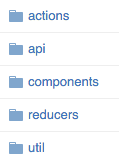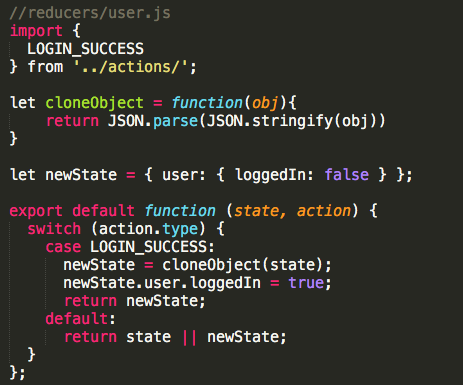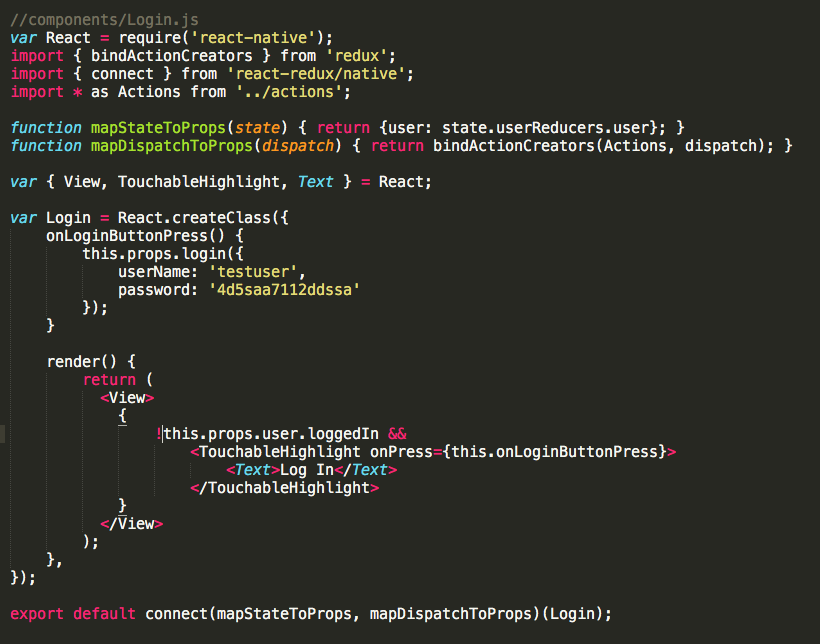In mobile development there is a need for architectural frameworks, but complex frameworks designed to be used in web environments may end up damaging the development process or even the performance of our app. Because of this, some time ago I decided to introduce in all of my React Native projects the leanest framework I ever worked with: Redux.
Redux is basically a state container for JavaScript apps. It is 100 percent library-agnostic so you can use it with React, Backbone, or any other view library. Moreover, it is really small and has no dependencies, which makes it an awesome tool for React Native projects.
Step 1: Install Redux in your React Native project.
Redux can be added as an npm dependency into your project. Just navigate to your project’s main folder and type:
npm install --save react-reduxBy the time this article was written React Native was still depending on React Redux 3.1.0 since versions above depended on React 0.14, which is not 100 percent compatible with React Native. Because of this, you will need to force version 3.1.0 as the one to be dependent on in your project.
Step 2: Set up a Redux-friendly folder structure.
Of course, setting up the folder structure for your project is totally up to every developer but you need to take into account that you will need to maintain a number of actions, reducers, and components. Besides, it’s also useful to keep a separate folder for your API and utility functions so these won’t be mixing with your app’s core functionality. Having this in mind, this is my preferred folder structure under the src folder in any React Native project:

Step 3: Create your first action.
In this article we will be implementing a simple login functionality to illustrate how to integrate Redux inside React Native. A good point to start this implementation is the action, a basic function called from the component whenever we want the whole state of the app to be changed (i.e. changing from the logged out state into the logged in state).

To keep this example as concise as possible we won’t be doing any API calls to a backend – only the pure Redux integration will be explained.
Our action creator is a simple function returning an object (the action itself) with a type attribute expressing what happened with the app. No business logic should be placed here; our action creators should be really plain and descriptive.
Step 4: Create your first reducer.
Reducers are the ones in charge of updating the state of the app. Unlike in Flux, Redux only has one store for the whole app, but it will be conveniently name-spaced automatically by Redux once the reducers have been applied.

In our example, the user reducer needs to be aware of when the user is logged in. Because of that, it needs to import the LOGIN_SUCCESS constant we defined in our actions before and export a default function, which will be called by Redux every time an action occurs in the app. Redux will automatically pass the current state of the app and the action occurred. It’s up to the reducer to realize if it needs to modify the state or not based on the action.type. That’s why almost every time our reducer will be a function containing a switch statement, which modifies and returns the state based on what action occurred.
It’s important to state that Redux works with object references to identify when the state is changed. Because of this, the state should be cloned before any modification.
It’s also interesting to know that the action passed to the reducers can contain other attributes apart from type. For example, when doing a more complex login, the user first name and last name can be added to the action by the action created and used by the reducer to update the state of the app.
Step 5: Create your component.
This step is almost pure React Native coding. We need a component to trigger the action and to respond to the change of state in the app. In our case it will be a simple View containing a button that disappears when logged in.

This is a normal React Native component except for some pieces of the Redux boilerplate:
- The three import lines at the top will require everything we need from Redux
- ‘mapStateToProps’ and ‘mapDispatchToProps’ are two functions bound with ‘connect’ to the component: this makes Redux know that this component needs to be passed a piece of the state (everything under ‘userReducers’) and all the actions available in the app.
Just by doing this, we will have access to the login action (as it is used in the onLoginButtonPress) and to the state of the app (as it is used in the !this.props.user.loggedIn statement)
Step 6: Glue it all from your index.ios.js.
For Redux to apply its magic, some initialization should be done in the main file of your React Native project (index.ios.js). This is pure boilerplate and only done once:

Redux needs to inject a store holding the app state into the app. To do so, it requires a ‘Provider’ wrapping the whole app. This store is basically a combination of reducers. For this article we only need one reducer, but a full app will include many others and each of them should be passed into the combineReducers function to be taken into account by Redux whenever an action is triggered.
About the Author
Emilio Rodriguez started working as a software engineer for Sun Microsystems in 2006. Since then, he has focused his efforts on building a number of mobile apps with React Native while contributing to the React Native project. These contributions helped his understand how deep and powerful this framework is.










![How to create sales analysis app in Qlik Sense using DAR method [Tutorial] Financial and Technical Data Analysis Graph Showing Search Findings](https://hub.packtpub.com/wp-content/uploads/2018/08/iStock-877278574-218x150.jpg)


